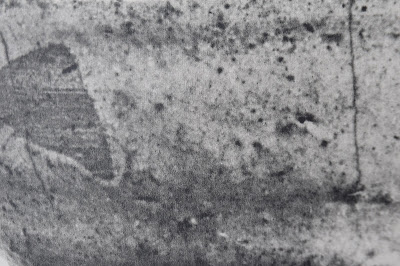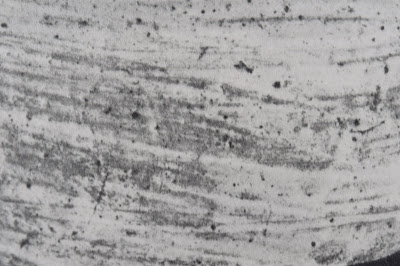Outpost 300124
The Dematerialized Space of the Image.
Drawing does not proceed from the object of perception, because the drawing 'itself' is desperate to keep hold of an absence – it all began with a silhouette of a shadow – on the wall.
The act of drawing dismantles consciousness and plunges the self into a zone of sensation and experience. No longer expressing the history and intentions of a subject, or the closures of representation. The work/drawing becomes thought that thinks itself through the material.
What drawing produces/proposes is a confrontation with the real of experience, prior to signification or the subject. It induces a 'sense'/'feeling' that stands in critical and often destructive relation to pre-existing codes of visual language or modes of interpretation.
To draw becomes to embody and manifest movement, which is neither the rhetoric of motion nor a parody of eros, but rather that what keeps the imaginary in the state of possibility and allows it to be both diachronic and synchronic, markings in times feeling.
In drawing there is no distinction between inside and outside.
In drawing we are no longer in the realms of distinctions.
There is no inside-out and vice-versa, because the threshold and its distinction was never passed.
The harmony of marks touches body and matter. Harmony determines transparency; it maintains the metonymic character of desire because it temporarily annuls the distinction between imaginary and image, between the labyrinth and elaboration. The imaginary keeps its own status of impalpability and moves in the interstitial where it loses the confines of here and now, inside and outside.
Stella Santacatterina.
Drawing into a corporeal sense of place.
Marks in 'times' feeling.
An image that adequately expresses both the efficacy and the temporiness of the phenomenon joining a diffuse invisible flow of energy that wends its way ceaselessly through the world, animating it as it goes.
Vital Nourishment.
Departing from Happiness.
Francois Jullien.
Nonsense drawing is about remaining in the simplicity of our origins, free from concepts and representations that veil things. The nonsense drawing is becoming thought.
Inside This Clay Jug.
Jackie Leven.
A vessel that still contains a quantum of energy.
The Egyptian Pot.
Hans Coper.
Samsara, a beauty fed on emptiness.
Sadhana, bearing the difficulties of existence.
Butades on loss, her lyrical and indexical inscription.
The awakening of inert objects (a table, a forest, a person that plays a certain role in the environment) which, emerging from their stability, transform the place where they lay motionless into the foreignness of their own space.
Stories thus carry out a labour that constantly transforms places into spaces or spaces into places.
They also organize the play of changing relationships between places and spaces.
A place is thus an instantaneous configuration of positions. It implies an indication of stability.
The Practice of Everyday Life.
Michel de Certeau. 1984
Drawing as actualizations of spaces, a spatializing frenzy of inscriptions becoming a textual place.
Drawings on narrative actions that organize feeling and their perspectives determined by a phenomenology of existing in the world; producing a graphic of actions and findings that are indicative to a situated body within the space of a practiced place.
INTIMUS.
Interior Design Theory Reader.
Drawing On Body Specificity/Space-Time/Place
What is explored as distinct spatial experiences, how is text narration explored as a negotiator between that which is seen, mapped and stable, and that which is experienced, toured and individuated.
Species of Spaces and Other Pieces.
Georges Perec. 1999.
The Apartment.
Georges Perec, renowned for his literary work, takes time to question the banal and mundane activities occurring in the spaces of our inhabitation. In 'The Apartment' he discloses the ordinariness of space when considered alongside functionality of room requirements, particularly when mapped through a slice of time. Against this method of narration, Perec proposes several other spatial layouts generated by either functional relationships between rooms, or the functioning of senses, or days of the week, or thematic arrangements.
Every apartment consists of a variable, but finite, number of rooms.
Each room has a particular function.
It would seem difficult, or rather it would seem derisory, to question these self-evident facts. Apartments are built by architects who have very precise ideas of what an entrance-hall, a sitting-room (living-room, reception room), a parents' bedroom, a child's room, a maid's room, a box-room, a kitchen, and a bathroom ought to be like.
It's not hard to imagine an apartment whose layout would depend, no longer on the activities of the day, but on functional relationships between the rooms. It takes a little more imagination no doubt to picture an apartment whose layout was based on the functioning of the senses.
In sum, a room is a fairly malleable space.
I don't know, and don't want to know, where functionality begins or ends. It seems to me in any case, that in the ideal dividing-up of today's apartments functionality functions in accordance with a procedure that is unequivocal, sequential and nycthemeral. The activities of the day correspond to slices of time, and to each slice of time there corresponds one room of the apartment.
Inside Fear : Secret Places and Hidden Spaces in Dwellings.
Anne Troutman.
I do not believe the house is a safe place. For me, it is a collision of dream, nightmare, and circumstance, a portrait of the inner life. The primal shelter is also the site of primal fears. Its interiors are a map of the conscious and unconscious, with conscious securities and insecurities visible in the main rooms, and unconscious ones lurking in smaller, peripheral spaces. There is danger in the house.
In this semi-autobiographical account of childhood spaces, Anne Troutman suggests that dwelling holds an intimate, mirror-like relationship so that we dwell in the home and the home dwells in us. This Freudian connection, dividing and connecting inner and outer selves, gathers hidden spaces with visible house, and cloaks the visual with other senses such as fear, terror, fright and anxiety. Discussed this way the storyteller's relived world is contingent on conscious and unconscious associations that redefine the interior through psychological space.
Intimus, Interior Design Theory Reader. Mark Taylor and Julieanne Preston.
Spatial Stories.
Spatial practices concern everyday tactics, they are part of them, from the alphabet of spatial indication, the beginning of a story of which the rest is written by footsteps, to the daily news, to legends and myths. These narrative adventures, simultaneously producing geographies of actions and drifting into the commonplaces of an order, do not merely constitute a 'supplement' to pedestrian enunciations and rhetorics. They are not satisfied with displacing the latter and transposing them into a field of language. In reality, they organize walks. They make the journey, before or during the time the feet perform it.
Michel de Certeau.
Drawing Space/Discourses of The Body.
Enunciative Focalizations ( the indication of the body within discourse).
Markings, utterances and graphic gestures caught in the ambiguity of an actualization, transformed into a form dependent upon many different conventions, that are situated by the act of the present, (nowness) and modified by the translations/transformations caused by successive inscriptions and their contexts.
Situated selves, of being situated by desire, indissociable from a direction of existence and implanted in the space of a landscape.
There are as many spaces as there are distinct spatial experiences, the perspectives of which are determined by a 'phenomenology' of existing in the world.
M Merleau-Ponty.
Michel de Certeau establishes 'Spatial Practice' as the proliferation of metaphors/spatial trajectories (stories that traverse and organize places, that link and select, that can make sentences and itineraries). He is interested in the role narrative plays in both reading and acting in space as a theatre of actions that accumulates meaning and relevance over and through time, and that spatial experiences are specific to each body, time and place.
A space exists when one takes into consideration vectors of direction, velocities, and time variables. Thus space is composed of intersections of mobile elements. It is in a sense actuated/performed by the ensemble of movements deployed within it. Space occurs as the effect produced by the operations that orient it, situate it, temporalize it, and make it function in a polyvalent unity of conflictual programs or contractual proximities.
In short, space is a practiced place. Thus the street geometrically defined by urban planning is transformed into a space by walkers. In the same way , an act of reading is the space produced by the practice of a particular place: a written text, i.e., a place constituted by a system of signs.
Printed Drawing.
Figural markings and frottage on cyanotype surface.
Languages that inform on/and interrogate drawings.
DRAWING FORMAL ELEMENTS and vocabulary.
Found document, hand-out for students AS/A2 Brockwood Art Barn.
1. Format: portrait, landscape.
2. Scale and Proportion: Systems of measurement:
Calculating relative size by counting.
Outstretched pencil covered by thumb.
Linking up with markers suggested by other objects and intersecting lines within the environment.
3. Dynamic relationship: The straightness or curve of the central axis; relative angles of neck, limbs, to the rest of the body or surrounding furniture etc.
4. Composition and design: point of focus (close-up, distant view) featuring human figure in space. The whole sheet of paper must be owned - even where there are no marks, this is still part of the composition – positive and negative space.
5. Perspective: When drawing from life we translate what we see as 3D spatial relationships onto 2D picture plane. Recessional space or depth in a drawing is achieved through correct calculation of: Vanishing Points, Horizontal Line, Foreshortening, Volume.
6. Line quality: Outline is only used where a shadow is visible, very often not necessary.
7. Pattern: Mark making; repeated elements that contribute to the structure of the whole; organisation of the elements or parts, in the way that feathers are arranged in a bird's wing, or the leaves on branches of a tree.
8. Tonal values: Greyscale; highlight, shadow; colour of ground; distribution of weight in terms of light and darks.
9. Colour: Wet and dry media; combining complementary, secondary, tertiary relationships; also (as with tonal values) hues, tints and shades.
Helgate Proposal Review.
Anglian Potters.
Why clay?
How has clay shaped you?
Ceramics
Visual Fine Art.
Teaching in Art Education




.jpg)





.jpg)





.jpg)

.jpg)




.jpg)









